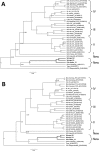Lassa Virus in Pygmy Mice, Benin, 2016-2017
- PMID: 31365854
- PMCID: PMC6759236
- DOI: 10.3201/eid2510.180523
Lassa Virus in Pygmy Mice, Benin, 2016-2017
Abstract
Lassa virus has been identified in 3 pygmy mice, Mus baoulei, in central Benin. The glycoprotein and nucleoprotein sequences cluster with the Togo strain. These mice may be a new reservoir for Lassa virus in Ghana, Togo, and Benin.
Figures

References
-
- World Health Organization. Lassa fever–Benin [cited 2016 July 1]. http://wwwwhoint/csr/don/13-june-2016-lassa-fever-benin
-
- Fichet-Calvet E. Lassa fever: a rodent-human interaction. In: Johnson N, editor. The role of animals in emerging viral diseases. London: Elsevier; 2014. p. 89–123.
-
- Olayemi A, Obadare A, Oyeyiola A, Fasogbon A, Igbokwe J, Igbahenah F, et al. Small mammal diversity and dynamics within Nigeria, with emphasis on reservoirs of the Lassa virus. Syst Biodivers. 2017;15:1–10.
Publication types
MeSH terms
LinkOut - more resources
Full Text Sources

